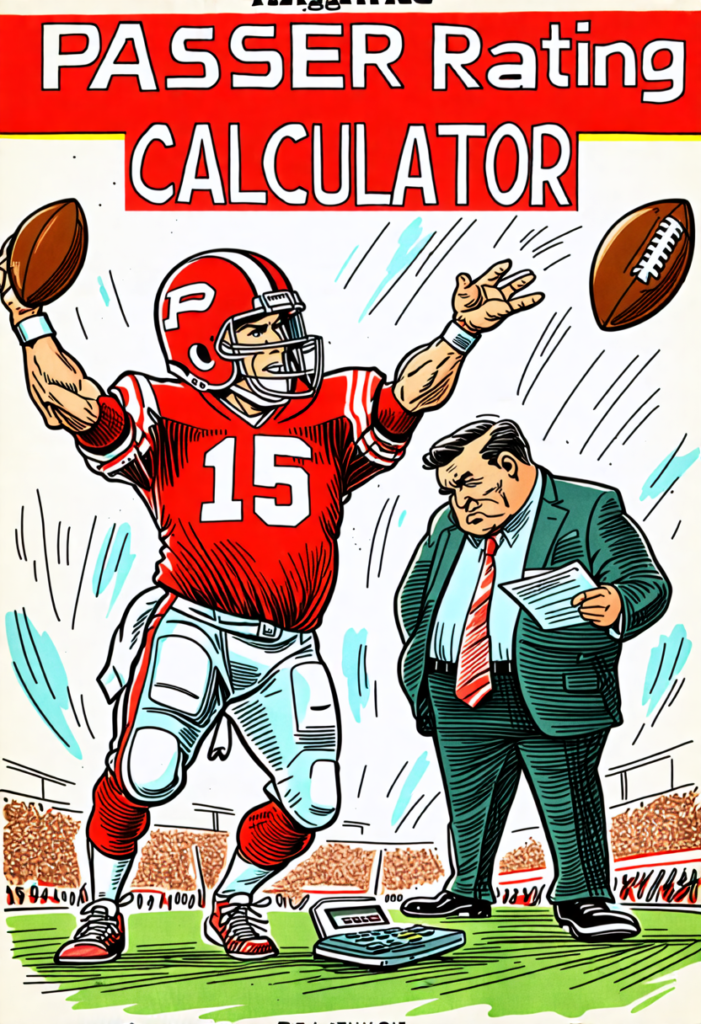Passer Rating Calculator
NFL/CFL Passer rating: 0
NCAA Passer rating: 0
The passer rating calculator helps you calculate your NFL/CFL and NCAA passer ratings.
Enter the number of passing attempts, completions, passing yards, touchdowns, and interceptions to determine your passer rating.
In case you don’t know, passer rating is a way to measure how well passers, mostly quarterbacks, do their jobs in gridiron football.
NFL and NCAA have different passer ratings.
NFL passer ratings are 0–158.3. Since 158.3 is the quarterback’s highest rating, it’s considered perfect. Over 100 is considered good.
The NCAA statistic has a maximum value of 1,261.6 and a minimum of -731.6.

You might be interested in finding bike pace or your dunk efficiency.
What is a pass rate?
Passer rating, also known as quarterback rating or QB rating, is a statistical measure used to evaluate the performance of quarterbacks in American football. This rating system takes into account various aspects of a quarterback’s passing performance, providing a single number that represents their overall efficiency.
The passer rating was adopted by the NFL in 1973 as a means to standardize quarterback assessment. It considers four key statistics:
- Completion percentage
- Yards per attempt
- Touchdown percentage
- Interception percentage
These factors are combined using a specific formula to produce a single rating score. In the NFL and Canadian Football League (CFL), the passer rating scale ranges from 0 to 158.3, with 158.3 being considered a “perfect” passer rating.
The Importance of Passer Rating in Football
Passer rating serves as a valuable tool for coaches, analysts, and fans to assess a quarterback’s performance objectively. It provides insights into a quarterback’s efficiency and effectiveness in moving the ball down the field and scoring touchdowns while avoiding interceptions.
Some key points about the importance of passer rating include:
- Performance Comparison: Passer rating allows for easy comparison between quarterbacks, regardless of the number of passing attempts.
- Historical Context: It enables comparisons of quarterback performances across different eras of the game.
- Team Strategy: Coaches can use passer ratings to inform decisions about play-calling and game strategy.
- Player Evaluation: Scouts and team managers often consider passer ratings when evaluating potential draft picks or free agent signings.
How to Calculate Passer Rating: NFL and NCAA Formulas
The passer rating calculation differs between the NFL/CFL and the NCAA. Let’s explore both formulas:
NFL/CFL Passer Rating Formula
The NFL passer rating formula involves several steps:
- Calculate the completion percentage:
((Completions / Attempts) – 0.3) * 5 - Calculate the yards per attempt.
((Yards / Attempts) – 3) * 0.25 - Calculate the touchdown percentage.
(Touchdowns and Attempts) * 20 - Calculate the interception percentage:
2.375 (Interceptions and Attempts) * 25
For each of these calculations, the result is capped at 2.375 and cannot be lower than 0. The final passer rating is then calculated by adding these four values, dividing by 6, and multiplying by 100.
NCAA Passer Efficiency Formula
The NCAA uses a different formula, often referred to as the passing efficiency rating:
((8.4 * Yards) + (330 * Touchdowns) + (100 * Completions) – (200 * Interceptions)) / Attempts
This formula produces a score that typically ranges from about 0 to 200, although scores above 200 are possible in exceptional cases.
Using the Passer Rating Calculator
Our passer rating calculator tool simplifies the process of determining a quarterback’s rating. Here’s how to use it:
- Enter the number of passing attempts
- Input the number of completions
- Add the total passing yards
- Enter the number of touchdown passes
- Input the number of interceptions
- Click the “Calculate” button
The calculator will then display both the NFL/CFL passer rating and the NCAA passer efficiency rating.
Interpreting Passer Rating Results
Understanding what the passer rating numbers mean is crucial for making sense of quarterback performance. Here’s a general guide for interpreting NFL passer ratings:
- 158.3: Perfect passer rating
- 100+: Excellent performance
- 85-99: Very good performance
- 70-84: Average to above-average performance
- 50-69: Below-average performance
- Below 50: Poor performance
Limitations of Passer Rating
While passer rating is a useful metric, it’s not without its limitations:
- It doesn’t account for rushing yards or touchdowns, which can be significant for mobile quarterbacks.
- Sacks and fumbles are not factored into the calculation.
- The difficulty of passes or the quality of the receiver’s catch are not considered.
- It doesn’t take into account the game situation or the strength of the opposing defense.
- The formula can sometimes produce counterintuitive results for extreme stat lines.
Notable Passer Rating Records and Achievements
Throughout NFL history, several quarterbacks have achieved remarkable passer ratings. Here are some notable examples:
- Highest Career Passer Rating: Aaron Rodgers holds the record for the highest career passer rating in NFL history with a rating of 103.9 (as of 2021).
- Perfect Passer Rating Games: As of 2021, there have been 75 instances of a quarterback achieving a perfect 158.3 passer rating in a single game (minimum 10 attempts).
- Highest Single-Season Passer Rating: Aaron Rodgers set the record for the highest single-season passer rating in 2011 with a rating of 122.5.
- Rookie Passer Rating Record: Dak Prescott holds the rookie record with a 104.9 rating in 2016.
Passer Rating in Different Leagues: NFL, NCAA, and CFL
While we’ve primarily focused on the NFL, it’s worth noting that passer rating is used in other football leagues as well, with some variations:
- NFL and CFL: Both leagues use the same passer rating formula, with a scale from 0 to 158.3.
- NCAA: College football uses the passing efficiency rating, which typically ranges from 0 to 200+.
- High School: Many high school leagues use a simplified version of the passer rating formula.
The Evolution of Quarterback Evaluation Metrics
While passer rating has been a staple of quarterback evaluation since 1973, the football analytics community continues to develop new metrics to assess quarterback performance. Some of these include:
- QBR (Total Quarterback Rating): Developed by ESPN, this metric aims to capture all of a quarterback’s contributions, including rushing and sacks.
- DVOA (Defense-adjusted Value Over Average): This metric adjusts a quarterback’s performance based on the strength of the opposing defense.
- EPA (Expected Points Added): This measures the value of each play in terms of the points it’s expected to add to the team’s score.






